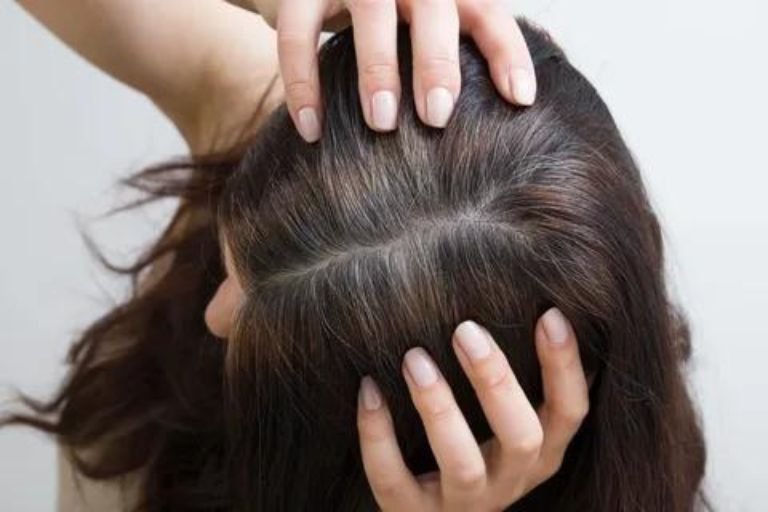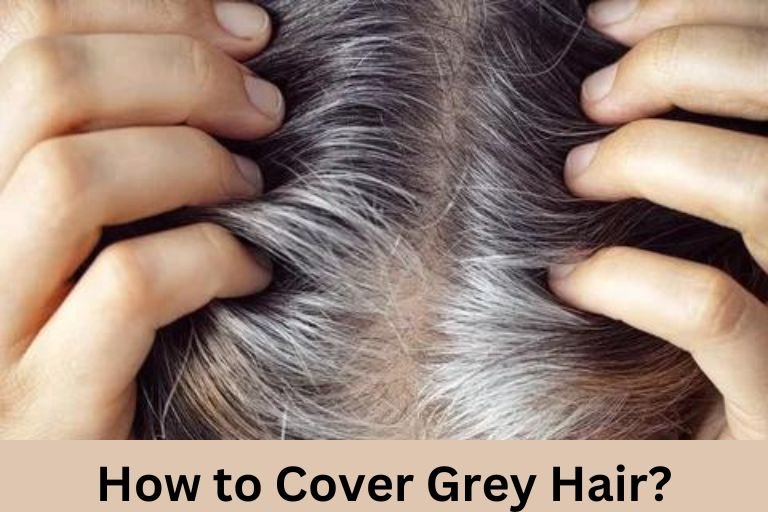As we get older, our hair may start to turn gray. Some people like their gray hair, while others want to hide it to look younger. If you want to cover your gray hair, there are many options. You can use traditional methods or new products for different hair types and lifestyles. Let’s explore how to cover gray hair in our guide!
Why Hair Turns Gray
Your hair turns gray as you age because it is hard to hold color. This happens because of changes in your hair as you get older. There are many reasons.
Aging
As we age, our hair naturally turns gray. This happens because the cells that make melanin, which gives hair color, become less active. Embracing gray hair can make us feel strong and wise, revealing our life experiences.
Instead of seeing gray hair as a sign of aging, consider it a symbol of the challenges we’ve faced and overcome. Each gray strand tells a story of our life’s journey, filled with happy moments, strength, and personal growth.

Melanin Fades
Melanin fading can happen faster due to stress and genetics. It’s not just about getting older but also about how we live. Accepting the natural change in hair color shows our personal and biological story.
Taking care of our overall well-being is vital for healthy hair. Seeing a gray hair care routine as a symbol of wisdom can help us feel more confident as we age. Each strand of hair tells a different story, showing diversity and strength as we embrace the journey of graying hair.
Hair Bleaches Itself
Gray hair is a natural part of aging caused by hydrogen peroxide. As we age, enzymes that break down hydrogen peroxide in our hair decrease. This allows hydrogen peroxide to build up and lighten our hair. This gradual lightening leads to our hair changing from its original color to gray or white.
Understanding this process helps us see how our hair ages. Instead of just thinking that hair is from a lack of pigment, knowing about hydrogen peroxide gives us a better understanding of how our bodies change over time. Being curious and accepting of these changes can help us appreciate the beauty and uniqueness of each stage of life.
Dry Hair
As we age, our scalp produces less oil, making our hair dry and rough. This lack of moisture can also make our hair feel dehydrated and coarse. Changes in melanin levels also affect the texture of aging hair, so it’s important to use moisturizing products designed for older people to help improve the condition of dry, mature hair.
Understanding why hair turns gray can help us understand why it becomes dry as we age. Due to reduced melanin production and oil gland activity, older hair needs special care to stay healthy and vibrant.
Hydrating treatments and techniques in your haircare routine can help combat dryness and improve the quality of your aging hair.
Stress, smoking
Stress and smoking can speed up hair turning gray. Stress releases hormones that can affect hair color, while smoking adds harmful chemicals that damage hair cells.
Genetics mainly decide when hair turns gray, but stress and smoking also play a role. It is essential to manage stress with activities like mindfulness and exercise. Quitting smoking can improve lung health and slow down premature graying.

Why Won’t My Gray Hair Dye?
Gray hair may not take dye well because it has less natural pigment. As we age, our hair follicles make less melanin, which gives hair its color. When there isn’t enough melanin, dye may not stick to gray hair properly, leading to a faded or uneven color. Here, we discuss why we would not use our gray hair dye.
No Melanin Or Pigment
Gray hair can be challenging to color because it lacks pigment. But don’t worry, special dyes are made to color gray hair. These dyes are designed to work on stubborn gray strands. So, if you’re wondering why your gray hair won’t dye, know that solutions are available. But there are many best ways to cover gray hair.
Rough And Dry Texture
Gray hair’s resistance to color absorption goes beyond just the lack of natural oils; it’s also about the increased porosity of the strands. The rough and dry texture of gray hair creates tiny gaps in the cuticle, making it difficult for hair dye to penetrate and hold onto the strands effectively. This is why achieving a long-lasting and vibrant color on gray hair can be challenging.
The lack of hydration in this area exacerbates the difficulties in sealing the cuticle, resulting in uneven color absorption and fading. Embracing these unique characteristics of gray hair is essential when seeking successful and lasting color results, requiring specific care and attention tailored to its individual needs.
Thick, Coarse Cuticle
Coloring thick, coarse gray hair can be challenging because the dye may not penetrate the hair’s tough outer layer easily. This outer layer thickens with age, making it harder for the color to cover the hair entirely. Some people use strong chemicals to open this layer, harming the hair.
To improve results, use deep conditioning treatments before coloring to soften the hair and help the color stick better. After coloring, keep the hair moisturized and healthy. By holistically coloring thick, coarse gray hair, you can achieve good results with less damage.
Darker Color
To cover stubborn gray hair, try a darker color like the brunette. It lasts longer and hides white strands well. Dark colors look rich and stylish, giving a timeless and versatile look.
If light blonde hair has been frustrating, switching to brunette can be a nice change. Brunette tones enhance your natural features and add depth to your look. Dark colors go well with different skin tones and styles, making them an excellent choice for a simple but impactful hair change.
Dyes Infused With Botanical Oils
When dyeing, use nourishing botanical oils to help your gray hair keep its color. Oils like argan, coconut, and jojoba hydrate dry gray hair, making it better at holding color. By adding moisture to these oils, you not only boost hair health but also improve color retention.
When coloring gray hair, be patient and gentle. Thorough coverage and careful application help gray hair absorb and keep dye without harm. Paying attention during coloring keeps your hair vibrant and healthy.
Saturate Strands With Dye
Cover your head with plastic while the dye sets to trap heat and help stubborn areas, like near your temples, absorb color better. These steps can improve the vibrancy and lasting color of your dyed gray hair, giving you a flawless look.
Waiting longer than the dye’s instructions suggest can help the color penetrate your hair better, especially in areas that are harder to color. By reapplying dye to resistant areas, like near the temples, you allow them to match the rest of your hair. Putting in more time and effort during coloring can significantly improve how well your gray hair holds onto its new color, ensuring a consistent and beautiful look.

How To Cover Gray Hair Without Dye
One way to hide gray hair without dye is by using hair mascara. This temporary option lets you color specific gray strands, blending them with your hair color for a natural look. Another choice is tinted dry shampoo, which quickly covers gray roots between washes. Trying different hairstyles like braids, updos, or hats can also help stylishly hide gray hair.
For a more lasting solution without traditional dyes, henna is a good option. Henna gives the hair a natural reddish color while effectively covering gray strands. Eating foods rich in antioxidants and vitamins can improve hair health and slow down graying naturally. Gracefully embracing your naturally gray hair is another empowering choice to show your unique beauty at any age.
Best Color To Cover Gray Hair
Many people worry about gray hair as they get older. Picking the right color can significantly affect how natural and flattering it looks. Instead of black or dark brown, consider softer tones like ash blondes or cool browns. These colors blend better with gray hair and help eliminate any yellow tones. Adding highlights or lowlights in platinum blonde or steel gray can give a modern and stylish look.
Trying out different colors and techniques can help find the best option to match skin tone and style while covering gray hair. The best color choice depends on personal preferences and goals. Whether going for subtle tones or bold contrasts, exploring different options can lead to finding the perfect shade that hides grays and boosts confidence and style.
Low Maintenance Color To Camouflage Gray Hair
Embracing gray hair doesn’t mean giving up on your style. It’s a chance to refresh your look with easy color techniques. Colors like soft caramel, sandy blonde, or deep chestnut blend well with gray hair, adding warmth and depth. These shades lessen the contrast between your natural color and gray, making your skin glow.
Balayage and ombre are great options for low-maintenance color. They create a smooth transition, allowing your natural color to grow without harsh lines, so you won’t need to visit the salon often. Adding highlights in warmer tones can also help hide gray roots while letting you enjoy both colors together. This stylish choice enables you to embrace effortless beauty and gives you more time for what you love!
Conclusion
How to Cover Gray Hair? Covering gray hair is a personal choice, and many solutions are available. Temporary options like hair color sprays, root touch-up products, and more permanent solutions like professional salon coloring or at-home dye kits can help achieve the desired look.
Consider factors like maintenance, cost, and potential hair damage when choosing a method. The best approach is one that makes you feel confident and comfortable. Embrace your natural beauty or try different styles—the choice is yours! Take control of your hair journey and find the perfect solution to cover gray strands.
Frequently Asked Questions
How do you cover gray hair around the hairline?
Covering gray hair at the hairline can be challenging, but there are ways to do it. One way is to use a root touch-up product. These products come in sprays, powders, or pens and can be applied to the hairline to temporarily hide grays.
Can gray hair turn black again?
Once hair turns gray, it can’t go back to black. Gray hair happens when the hair follicles make less melanin, which makes the hair lose its color and look gray or white. Hair dyes or treatments can temporarily cover gray hair and make it look darker, but they don’t change the hair’s color.

